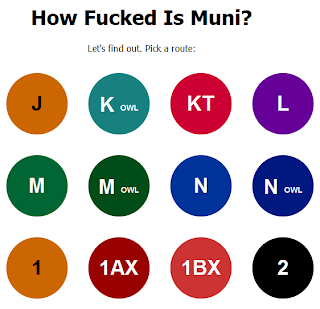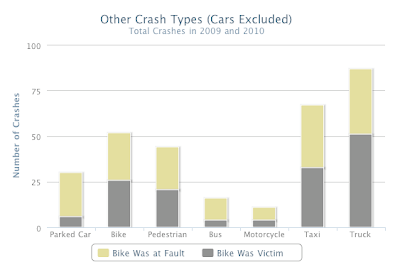
“HowFuckedIsMuni.Com”



In preparation for the 2013 America’s Cup yacht race taking place on our city’s waterfront, Mayor Ed Lee is working towards improving Embarcadero’s pedestrian, bike, and transit congestion.
These changes can really make a big difference to the waterfront, not just for the event, but permanently. If there are any changes you want to see, this is the time to suggest them. And hopefully, after the tourists have all gone home, they’ll leave behind a more commuter-friendly Embarcadero.
A meeting at City Hall on Tuesday discussed the climbing political pressure to bring about a quick fix to pedestrian danger. The problem has long been established and addressed, so what’s taking so long to solve it?
Last we heard of him, Nat Ford was on his way to being the new head of the Metropolitan Washington Airports Authority. But, according to theWashington Post, late Wednesday, Ford received a message from DC informing him that they’ve “reopened the search” for potential candidates.
A month from now, Nathaniel Ford will be finding out whether or not he has been offered the spot as the new president and CEO of the Metropolitan Washington Airports Authority.
During 20 inspections conducted between July 2009 and January of this year, The CPUC discovered repeated safety violations that might potentially endanger Muni’s passengers. In their official press release, the CPUC said that they are particularly concerned with “the material condition of the light rail system, SFMTA’s failure to initiate or complete Corrective Action Plans to address known problems, late reporting or non-reporting of incidents, and failure to respond to CPUC inspection findings.”
Despite these penalty threats, the SFMTA is optimistic and have expressed their confidence in being exonerated of all accusations.
The Bay Citizen recently reported on rising bike accidents and their leading causes and locations, using data reported to the SFPD within the last two years. With helpful infographics, the article provides statistics and viewpoints both bicyclists and drivers should be aware of.
The Mission: 96 accidentsSouth of Market: 85 accidentsDowntown: 68 accidentsWestern Addition: 41 accidentsFinancial District: 34 accidentsInner Richmond: 27 accidentsCastro-Upper Market: 27 accidentsHaight-Ashbury: 22 accidentsOuter Mission: 16 accidentsNorth Beach: 15 accidentsBernal Heights: 13 accidentsLakeshore: 12 accidentsBayview: 11 accidentsOuter Sunset: 11 accidents


Kate McCarthy, 31, was biking up Mission Street in February 2009 when a recreational vehicle going the opposite direction made an illegal left turn right in front of her. She swerved, but still collided with the giant vehicle, crashing her bike and cutting her face. After a police officer showed up to take the report, he refused to cite the driver, even though there were several witnesses, according to McCarthy. The officer would not write up a police report assigning fault. McCarthy filed a complaint with the city’s Office of Citizen Complaints. Three months later, the body ruled that the police department should have issued a report.
While six accidents happened in 2009, eight occurred in 2010 — all of them taking place after the improvements were made. Almost every crash here is caused by cars making illegal right turns. “The more things they try there, it doesn’t really help,” said Shaana Rahman, a lawyer who has represented two cyclists in Market/Octavia crashes. “I feel like the answer is to let the cars go right and move the bike lane to a mid-bike lane.”
On Wednesday night, AC Transit’s 72-line bus was shot at multiple times with one bullet breaking a rear window. One passenger was injured by the shattering glass and police are still investigating the circumstances and motives behind the shooting.

Disclaimer | Copyright © 2025 Rahman Law PC All Rights Reserved.